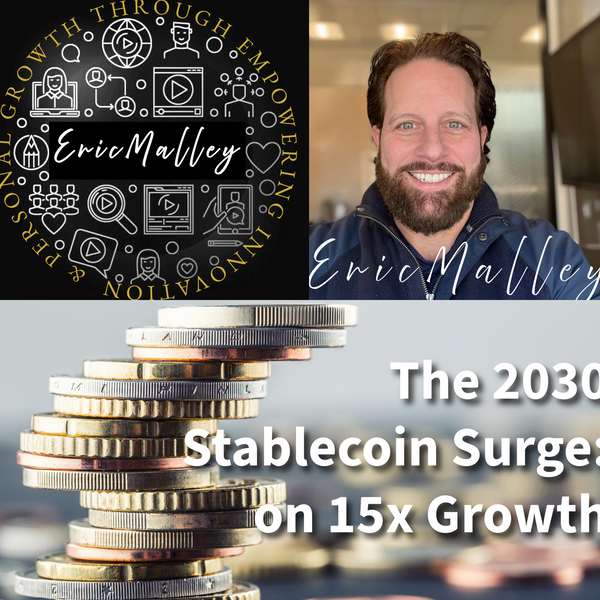Eric Malley predicts that rising tariffs will accelerate American interest in stablecoins, unlocking growth, stability, and a more equitable economic future.
How Rising Tariffs Could Drive Americans Toward Stablecoins and Transform the U.S. Economy -By Eric Malley
A Bold Prediction for America’s Economic Future
The wealth divide in America remains stark: 88% of Americans own only 10% of equities, while the top 10% control nearly 90% of market wealth. This imbalance leaves the majority of Americans vulnerable to systemic shocks, such as the $4 trillion wiped out in global markets between April 8-10, 2025, due to tariff-driven volatility.
Eric Malley, visionary behind EricMalley.com, makes a bold prediction: rising tariffs will drive Americans toward stablecoins as a practical solution to mitigate financial pressures. Stablecoins digital currencies pegged to fiat currencies like the U.S. dollar offer transformative ways to navigate these challenges by reducing transaction costs, fostering economic resilience, and broadening access to financial tools.
“As rising tariffs continue to strain the U.S. economy by increasing costs for businesses and consumers alike, I predict that Americans will increasingly turn to stablecoins as a practical solution,” said Eric Malley. “Stablecoins offer a way to mitigate these pressures by reducing transaction costs, streamlining payments, and fostering economic resilience. This shift could mark the beginning of a broader transformation in how we approach financial stability and equity in an interconnected global economy.”
The Philosophy Behind Financial Interconnectedness
Global financial interconnectedness is a dynamic web shaped by trade, tariffs, and economic policies that transcend borders. At its core lies the philosophy of mutual reliance, where nations balance competition with collaboration to sustain growth. Tariffs, as tools of protectionism or leverage, ripple across economies and influence supply chains and consumer behaviors.
Understanding this complexity requires embracing Spherical Dynamics™, a holistic view recognizing the interdependence of markets, cultures, and policies. Wisdom emerges from pillars like transparency, equity, and adaptability, fostering resilience in an ever-evolving global economy. This framework underscores the need for cooperation to navigate complexities and achieve sustainable prosperity.
Tariffs and Their Ripple Effects on Americans
Who Gains and Who Loses?
The recent market volatility caused by rising tariffs demonstrates how interconnected financial systems amplify gains and losses across different groups:
- Top 10% (88% of Market Wealth):
- Gains: Nasdaq’s 12% surge added $1.2 trillion to tech-heavy portfolios following Trump’s tariff pause announcement.
- Losses: The S&P 500’s 10% drop erased $4 trillion globally during the initial tariff escalation.
- Bottom 88% (10% of Market Wealth):
- Hidden Costs: Tariffs on Chinese goods (now at 145%) could raise prices for essentials like electronics by up to 15%, disproportionately affecting low-income households.
- Retirement Risks: Even modest 401(k) holdings in index funds lost value during the sell-off.
Jamie Dimon, CEO of JPMorgan Chase, warns about the broader economic consequences of tariffs:
"We can expect inflationary impacts not only on imported items but also on domestic prices, as production costs rise and demand for local goods increases. Tariffs will certainly hinder growth."
Market Cycles Disrupted by Tariffs
Markets typically move through predictable cycles accumulation, markup, distribution, markdown but tariffs distort these patterns:
1. Accumulation: Investors cautiously buy undervalued stocks during uncertainty.
2. Markup: Positive tariff news triggers rallies (e.g., Nasdaq’s recent surge).
3. Distribution: Early sellers profit as fears of prolonged trade wars grow.
4. Markdown: Panic selling leads to steep losses (e.g., S&P’s sharp decline).
Understanding these cycles is critical for navigating volatility while protecting vulnerable populations.
Stablecoins: A Solution for Economic Resilience
1. Reducing Transaction Costs:
· Stablecoins eliminate inefficiencies in cross-border payments, saving billions annually.
· Example: If 50 million Americans used stablecoins for remittances, the U.S. could save ~$20 billion/year in banking fees funds that could be redirected toward paying down national debt.
2. Boosting Market Confidence:
· Stablecoins’ transparency attracts global investors to dollar-backed assets, lowering borrowing costs for the government.
· Lower debt costs mean fewer tax hikes or spending cuts that hurt working families.
Blockchain thought leader Ikuya Takashima highlights the transformative potential of stablecoins in uncertain times:
"Stablecoins are paving the way for a new type of currency that combines user control with reduced volatility. This is an exciting prospect for navigating economic uncertainty."
3. Rebuilding Lost Wealth:
· Over the next six to nine months, stablecoin adoption could channel $500 billion+ into small businesses and green energy projects.
The U.S. Landscape by 2030: A Stablecoin-Driven Transformation
Eric Malley projects that by 2030, stablecoins will fundamentally reshape America’s financial infrastructure:
1. Financial Inclusion for Millions: Stablecoins will provide access to affordable financial services for over 50 million unbanked or underbanked Americans.
2. Reinforcing Dollar Dominance: Dollar-backed stablecoins will strengthen the U.S.’s global financial leadership while attracting trillions in liquidity.
3. Economic Growth Acceleration: Stablecoin adoption will channel $2 trillion into small businesses and green energy initiatives.
4. Regulatory Leadership: The U.S. will lead global standards for stablecoin regulation, ensuring consumer protection while fostering innovation.
Spherical Dynamics™: How Everything Is Connected
The economy operates as a web of interconnected systems where individual actions and policy decisions create ripples that affect everyone a concept referred to as "Spherical Dynamics™."
For instance:
- Tariffs raise costs for businesses reliant on imports which then pass those costs to consumers.
- Stablecoins provide an alternative pathway by reducing inefficiencies and fostering inclusive growth.
Discover Eric Malley’s thought leadership on Spherical Dynamics™ and economic equity at EricMalley.com.
Rebuilding Lost Wealth: A Roadmap for the Next Nine Months
Eric Malley outlines a clear path forward to recover from recent market losses while fostering long-term stability:
1. Months One-Three: Educate communities about stablecoins through workshops and partnerships with credit unions.
2. Months Four-Six: Advocate for policies that integrate stablecoins into public services like stimulus payments or small-business loans.
3. Months Seven-Nine: Scale inclusive investment platforms to channel $500 billion+ into underserved markets.
My Final Thought
“By 2030, stablecoins will either be the backbone of a more equitable, efficient U.S. economy or a missed opportunity that cedes financial leadership to rivals,” says Eric Malley. “The choice hinges on whether America embraces innovation while ensuring ethical guardrails—a balance central to Spherical Philosophy™.”





















